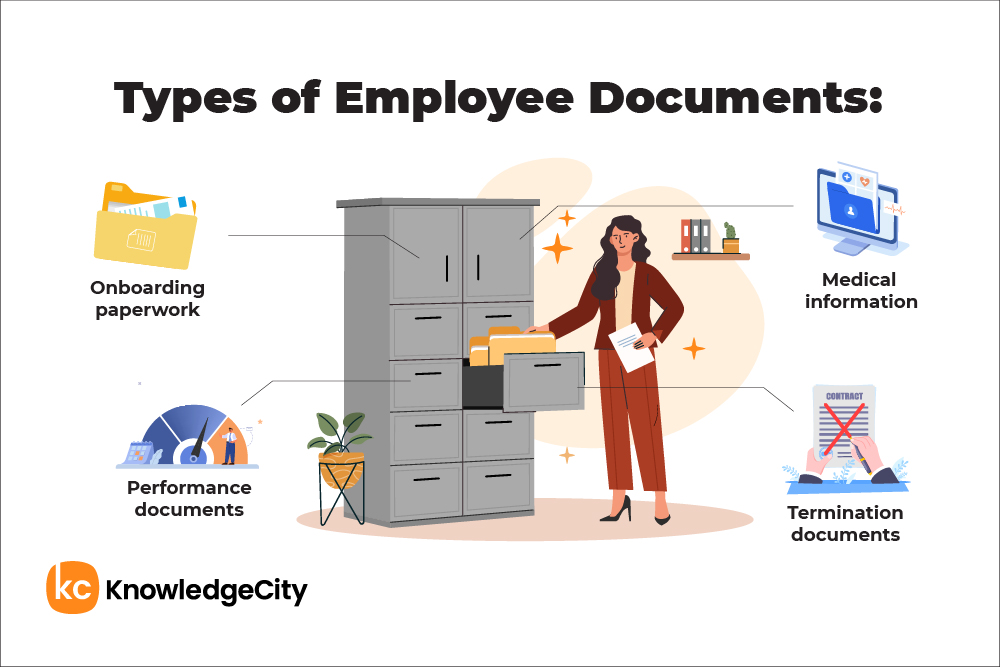Employee documentation is a vital part of running a business often necessary in order to remain compliant. It protects Human Resources, managers, and employees, setting both clear expectations and operating principles. But when documentation is done incorrectly, the company can be exposed to legal risk.
Common employee documentation mistakes include:
- Recording personal opinions or judgments
- Exaggerating or over-generalizing the situation
- Concluding prematurely and without an attorney’s input
But what exactly is employee documentation? What are the types, and why is it so critical? How can an organization create bulletproof employee documentation to ensure business continuity?

What Is Employee Documentation?
The simplest answer is “proof.” Employee documentation is evidence of conversations between employees and managers or HR. It gives everyone a clear historical record of what was expected, what was accomplished, and where the employee succeeded or underperformed.
Different locations—whether they are countries, states, regions, or cities—have their own laws about what records companies are required to keep. Human Resources often keeps additional records about employee history and performance so the management team can make informed decisions. These records can also reveal patterns or highlight when a role or assignment isn’t the best fit for an employee.
Employee documentation can be formal or informal. Information that’s critical to the employee, such as payroll and medical details, is formal documentation that usually has a standardized process and is collected for everyone. Performance improvement plans, disciplinary actions, and supporting feedback are examples of formal documentation that’s only required in certain situations.
A manager’s evaluation of an employee’s performance is a documentation task that’s important to do on a regular basis. Having a formalized, shared process across the company is a best practice. Other manager feedback can be more informal and include meeting notes, emails, communication through business tools, and notes in shared documents.
Types of Employee Documentation
Types of employee documents include onboarding paperwork, performance documents, medical information, and termination documents.
Onboarding paperwork includes application and offer details, contracts, signed agreements, and payroll information. Human Resources typically handles these. Ensuring that an employee is qualified for a role, understands their compensation, and acknowledges company policies is the best way to start someone off at work. That way, there are no surprises later.
Performance documents include regularly updated job deliverables and an unbiased evaluation of whether the employee is meeting their commitments. If the employee is a high performer, their accomplishments and training should be recognized on their permanent record for future managers to see.
If the employee is underperforming or has violated company policies, then it’s critical to record detailed examples of what they’re not doing well on. It’s also important to draft a clear improvement plan or disciplinary action report.
Medical information includes data often regulated by local laws, but many companies have processes for requesting medical leave or submitting an excused absence note from a doctor. Human Resources also needs emergency contacts and, for employees with disabilities, information about what accommodations are required to make the employee comfortable and able to complete their work.
Termination records include a resignation or termination letter, exit interview notes, and bookkeeping items such as insurance, paycheck end dates, and confidentiality reminders. Giving employees a chance to share their thoughts at an exit interview can bring a sense of closure and leave the relationship on better terms. It can also provide insights into what could be improved at the company or in the termination process.
Why Employee Documentation Is Critical
Hiring an employee begins a relationship between that person and the company, and both sides have expectations about how the job will go. Having comprehensive, accurate employee documentation helps set expectations on both sides early.
It also gives employees a chance to clarify their responsibilities if there’s misalignment between what the employee thinks their job responsibilities are and what they’re reading in the employee documentation. It’s important to discuss any conflicting ideas or confusing job tasks immediately so that the employee understands their role.
Documentation also gives managers the opportunity to have a transparent discussion with an employee about performance, ideally identifying problems early and working together to create a solution.
Documenting employee performance creates a record that managers and employees can refer to. When needed, they can also use records as the basis for an employee’s performance improvement plan, or PIP. This gives the employee clearly outlined steps that will help them get back on track or otherwise improve their performance.
There are also legal and compliance reasons to maintain employee documentation. Governments will regulate and monitor business practices like payroll, company policies, benefits, and other accommodations. Maintaining employee records keeps the business safeguarded in the event they must defend themselves in a legal setting.
Here’s an additional consideration: countries where an employee may be on a company-sponsored work visa. What’s the employee’s legal status in the country if they’re terminated? These cases might receive additional scrutiny from government agencies, so having the performance improvement plan and associated documentation for the employee is important. So is making sure HR is aware of the employee’s visa status.
If an employee’s visa status depends on their employment, there are often extra steps during their termination meeting to explain things like:
- How long they can remain in the country
- What options they have for remaining
- Finding new employment
- Or returning to their home country
The Basics of Bulletproof Documentation
Because employee documentation contains sensitive, personally identifiable information, it’s best practice to consult with a privacy expert when creating processes to handle and store employee information.
The City of Boston outlines their ABC’s of employee documentation like this:
- “Accurate: Record the facts objectively and in writing as they occur—do not rely on memory.
- Behavioral: Describe specific, observed behavior.
- Consistent: Be fair, detailed, and precise.”
One way to maintain accurate employee records is to have regular, documented meetings between the manager and the employee. The documentation should summarize what the meeting covered and what’s expected between now and the next meeting. For employees struggling with performance, these meetings should be at least once a week, and could also include additional written check-ins on the employee’s progress.
In the case where performance isn’t a concern, employee document management can often be included in email summaries or entries in a shared document or notebook. For employees that are struggling to meet performance expectations, HR may have a specific tool or location where managers must maintain employee records.
In addition to accurately recording the facts as they occur, it’s often helpful to get feedback and observations from co-workers and partner teams. This helps give a wider view of employee performance, their behaviors, and what impact they have on others. Having other perspectives often brings examples of observed behavior to light, which can be useful when coaching an employee.
It’s critical to remain as neutral as possible, measuring the employee against previously documented expectations using real, detailed examples of their work. Be sure not to let any personal bias influence an evaluation.
Once the gaps in performance are clearly laid out, the next step is identifying specific steps the employee should take to correct their performance and documenting the detailed components of a performance improvement plan.
Ideally, a PIP first goes through the factual examples recorded in the performance evaluation. Then it gives instructions for how those situations could have been handled differently to align with company policies. It should also describe what is expected from the employee going forward, including behaviors and deliverables.
As managers are going through employee performance improvement plans, employees should be given a chance to ask questions, share their side of the story, and request changes to the PIP if appropriate. This includes having employees officially document their response as a part of the performance evaluation or PIP.
Allowing employees to share feedback on their situation helps them feel empowered and valued as a partner in their own career management. If the employee struggles to understand the instructions or accept performance feedback, HR can be called in to mediate discussions.
According to Ann Zaslow-Rethabar, President of ISC Jobs, it’s crucial to set an expected time frame for the completion of actions in the PIP. A clear timeline of when the improvements or changes in behavior are expected helps the employee understand when their performance will be evaluated again and gives them a deadline to work towards.
Keep in mind that performance improvement plans don’t always work. When an employee can’t align their performance or behavior to company expectations, it’s important to outline what will happen if they don’t improve by a final deadline. Consequences should also be outlined so everyone has a mutual understanding of what the next steps are if an employee’s performance stays below expectations.
Consequences can include reassigning an employee to a different area or role that’s better suited to their skills, or demoting them so they have fewer responsibilities and expectations. Their employment could also be terminated to allow all parties to move on and seek other opportunities.
Managers should have regular check-ins with their employees to monitor progress against the PIP and give ongoing feedback to offer an employee the best chance for success.
It’s critical to continue employee documentation management best practices during this time to highlight whether the desired improvements are happening consistently over time, or if further corrective action—up to and including termination—is needed.
Steps for Drafting Bulletproof Documentation
Here are several solid steps you can take to create bulletproof documentation.
Complete onboarding and compliance documentation. When an employee is hired, ensure all business and government-required information is documented and stored correctly in a secure location.
Clearly define expectations and job responsibilities. Write down and discuss what an employee is expected to accomplish, by when, and what quality or quantity of work should be completed by each checkpoint.
Have regular check-ins. Meet consistently with employees and review their progress against the written expectations. Document successes and failures, changes in priorities, and any other discussed feedback or adjustments.
When employees don’t meet expectations, ramp up documentation efforts. If an employee is underperforming, documenting employee performance is even more critical. Detailed notes should be kept on what was communicated to them and when, and how they failed to meet performance improvement expectations.
Gather other perspectives. Get feedback on the employee from others involved in their daily work and add that to the employee documentation records the manager maintains.
Hear from the employee. Give them a chance to respond to the feedback and ask any questions they have to clarify why the results are unacceptable, then re-establish expectations.
Create a performance improvement plan. Continue to document expectations and specify what previous behaviors or outcomes need to change, in what way, and by when. Describe the consequences that will follow if those changes aren’t made.
Set regular checkpoints. In addition to having regular check-in meetings, set up regular checkpoints to review and monitor progress against the PIP specifically. Document positive and negative progress and any changes that are made.
If performance continues to decline, enforce the consequences. When managers have exhausted all options to correct behavior and performance, it’s time for the employee to face the consequences. Human Resources often guides the disciplinary process and acts as a helpful mediator and company policy expert.
For the last step, record the incident’s outcome. Every PIP, disciplinary action, or dispute should be formally documented and closed out. The outcome, including the consequences, should be both documented and reviewed by both the manager and the employee, and recorded with HR. If an employee is terminated, they may want to complete an exit interview to share their final feedback.
Subscribe to Our Newsletter
Join 80,000+ Fellow HR Professionals. Get expert recruiting and training tips straight
to your inbox, and become a better HR manager.

 Allison Bokone
Allison Bokone 
